History
In December 2001, a rectangular banner with an aspect ratio of 2:3 was approved, which consisted of two horizontal stripes, yellow and blue, in the ratio of 1:2. On the yellow strip there are three white towers with open gates. In the blue strip there is a yellow vertical sword with the hilt up and a horizontal yellow key.
After the remarks of the Ukrainian Heraldic Society regarding the coat of arms, the new decision on November 18, 2003 changed the flag of the region.

Shmankivchyky village in Ukraine, Ternopil Oblast, Chortkiv Raion, Zavodske settlement hromada. Administrative center of the former Shmankivchyky village council.
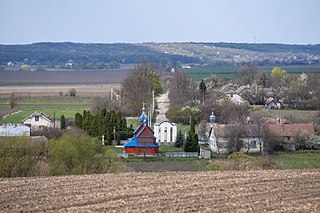
Shvaikivtsi is a village in Chortkiv Raion, Ternopil Oblast of Ukraine. It belongs to Zavodske settlement hromada, one of the hromadas of Ukraine. It is the administrative center of the former Shmankivchyky village council.
Zavodske settlement hromada (Ukrainian: Заводська селищна територіальна громада, romanized: Zavodska selyshchna terytorialna hromada is a hromada in Ukraine, in Chortkiv Raion of Ternopil Oblast. The administrative center is the urban-type settlement of Zavodske. Its population is 6,758
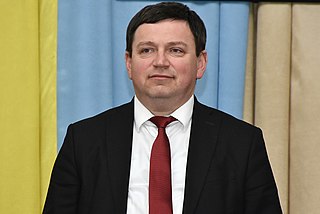
Bohdan Buiak or Bohdan Buyak is a Ukrainian educator, public figure, political scientist, doctor of philosophy (2013), professor (2013), correspondent member of the National Academy of Pedagogical Sciences of Ukraine (2019). Honored Worker of Education of Ukraine (2020).
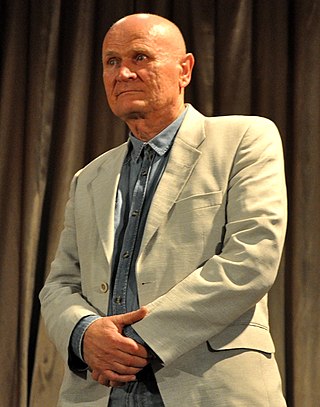
Petro Stepanovych Fedoryshyn is a Ukrainian journalist, editor, teacher, and sports figure. Honored journalist of Ukraine (2004). Member of the National Union of writers of Ukraine (2015). Candidate of philological Sciences (1996), docent (2004). Master of sports of the USSR in Sambo (1976), black belt holder in karate (1990). Winner of the Yaroslav Stetsko Ternopil regional prize (2013). Honorary Citizen of Chortkiv (2022).

The flag of the Kherson Oblast is the official symbol of the Kherson Oblast of Ukraine, along with the coat of arms. Approved by the decision of the Kherson Regional Council No. 440 of 25 October 2001.
Barysh is a village in Ukraine, Ternopil Oblast, Chortkiv Raion, Buchach urban hromada.
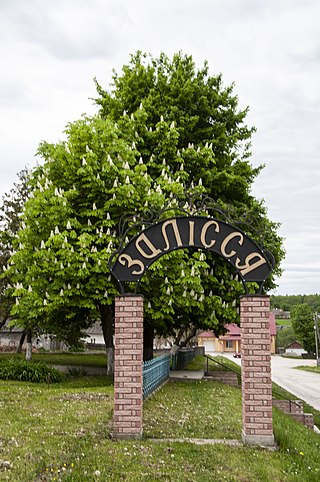
Zalissia is a village in Ukraine, Ternopil Oblast, Chortkiv Raion, Zavodske settlement hromada.
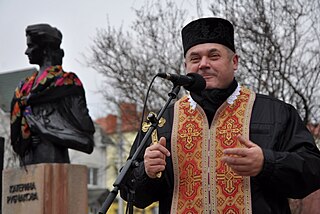
Volodymyr Volodymyrovych Zabolotnyi is a Ukrainian actor, public and religious figure, mitred priest (2023). Member of the Ternopil City Council (1990). He is the son of Mariia Potykevych-Zabolotna.

Kryvenke is a village in Ukraine, Ternopil Oblast, Chortkiv Raion, Husiatyn settlement hromada.
Bilche-Zolote rural territorial hromada is a hromada in Ukraine, in Chortkiv Raion of Ternopil Oblast. The administrative center is the village of Bilche-Zolote. Its population is 3,918
Buchach urban territorial hromada is a hromada in Ukraine, in Chortkiv Raion of Ternopil Oblast. The administrative center is the city of Buchach. Its population is 37,323
Kopychyntsi urban territorial hromada(Ukrainian: Копичинецька територіальна громада, romanized: Kopychynetska miska terytorialna hromada) is a hromada in Ukraine, in Chortkiv Raion of Ternopil Oblast. The administrative center is the city of Kopychyntsi. Its population is 12,959.

Yemelivka is a village in Kopychyntsi urban hromada, Chortkiv Raion, Ternopil Oblast, Ukraine.

Rudky is a village in Kopychyntsi urban hromada, Chortkiv Raion, Ternopil Oblast, Ukraine.
Zelene is a village in Hrymailiv settlement hromada, Chortkiv Raion, Ternopil Oblast, Ukraine.
Monastyrykha is a village in Hrymailiv settlement hromada, Chortkiv Raion, Ternopil Oblast, Ukraine.
Hai-Hrechynski is a village in Baikivtsi rural hromada, Ternopil Raion, Ternopil Oblast, Ukraine.
Novosilka is a village in Skalat urban hromada, Ternopil Raion, Ternopil Oblast, Ukraine.










